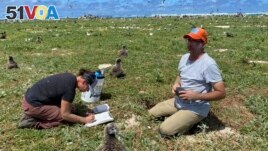Scientists increasingly are aiming to move animals threatened by rising temperatures to new areas where they never lived before in an effort to save them.
One example is a project in Hawaii that moved, or relocated, a seabird species from one island to another about 800 kilometers away.
Traditionally, scientists have considered the idea of species relocations risky. This is because it can cause problems for existing native animals.

This photo shows workers relocating a Tristram's storm petrel in Hawaii on March 29, 2022. (L. Young/Pacific Rim Conservation via AP)
But some scientists now believe such relocations are necessary to save threatened species. Moves have already been considered for several species, including birds, lizards, butterflies and even plants.
The relocation in Hawaii involved the Tristram's storm petrel, a seabird that is native to low-lying islands in Hawaii and Japan.
The project moved about 40 young birds from Hawaii's Tern Island to Oahu, one of the state's biggest islands. The Tristram's storm petrel is considered at risk of disappearing completely.
Tern Island is currently just 1.8 meters above sea level. Scientists fear the island may disappear completely if the sea level there continues to rise.
"Tern Island is washing away," said biologist Eric VanderWerf of the nonprofit group Pacific Rim Conservation. "Climate change is causing a greater need for this — for taking a species outside its known historical range."
Scientists hope the relocated animals can someday be returned to their native environments if conditions change.
A proposal by the administration of U.S. President Joe Biden would change the U.S. Endangered Species Act. The law aims to protect rare animals and plants. The change would make it easier to move some of the most threatened species to places where they have not been known to exist before.
As a reaction to that proposal, state wildlife officials and scientists have suggested moving populations of some species. These include the Key deer of southern Florida and the Karner blue butterfly from the Midwest and Northeast. In addition, officials are suggesting moving desert flowering plants in Nevada and California and the St. Croix ground lizard in the Virgin Islands.
Republican lawmakers in western states – including Montana, New Mexico and Arizona – are against the proposal. They say moving species to new places could create environmental problems and result in an "invasive species."
Federal officials are expected to finalize the proposal in June. Jason McLachlan is a biologist at the University of Notre Dame in the state of Indiana. He told The Associated Press he thinks the government proposal demonstrates an important change "in the way we think of species protection and conservation."
McLachlan said the issue goes beyond endangered species. He thinks it also raises questions about what should be considered "native" now that changing temperatures are pushing some species to seek out higher areas or move toward the planet's North or South.
He said comparable temperature changes in the past happened over thousands of years. But the current one is taking place over a shorter period and this has harmed ecosystems. "Eventually we're going to have to start thinking about it in ways that will make people…uncomfortable," McLachlan said. "To say this species is OK and this species is not OK, that's asking a lot of human beings."
Pacific Rim Conservation's VanderWerf told the AP that to save storm petrels, scientists need to act before populations have crashed. "In 30 years, these birds will certainly be rare, if we don't do something about it," he said.
James Watson is a scientist at the University of Queensland in Australia. He said, "Many, many species" must be moved or they could go out of existence. Watson added that increasing wildfires have forced some relocations of animals.
"This kind of intensive management is necessary for us to have a reasonable shot at holding ... some species," said Don Lyons, with the National Audubon Society's Seabird Institute.
I'm Bryan Lynn.
The Associated Press reported this story. Bryan Lynn adapted the report for Learning English.
_____________________________________________________________
Words in This Story
species – n. a group of animals or plants that are similar and can produce young animals or plants
range – n. a group of different things of the same general type
invasive – adj. moving into all areas of something and difficult to stop
conservation – n. an organized effort that aims to protect animals, plants and natural resources
ecosystem – n. everything that exists in a particular environment
uncomfortable – adj. not feeling comfortable and pleasant
management – n. the control and organization of something
